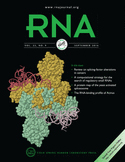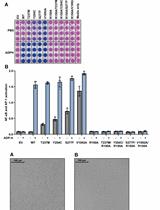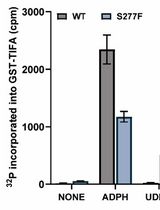- EN - English
- CN - 中文
RNA Degradation Assay Using RNA Exosome Complexes, Affinity-purified from HEK-293 Cells
使用从HEK-293细胞亲和纯化获得的RNA外泌体复合物进行RNA降解测定
发布: 2017年04月20日第7卷第8期 DOI: 10.21769/BioProtoc.2239 浏览次数: 9771
评审: Gal HaimovichAntoine de MorreeVaibhav B Shah
Abstract
The RNA exosome complex plays a central role in RNA processing and regulated turnover. Present both in cytoplasm and nucleus, the exosome functions through associations with ribonucleases and various adapter proteins (reviewed in [Kilchert et al., 2016]). The RNA exosome-associated EXOSC10 protein is a distributive, 3’-5’ exoribonuclease. The following protocol describes an approach to monitor the ribonucleolytic activity of affinity-purified EXOSC10-containing RNA exosomes, originating from HEK-293 cells, as reported in (Domanski et al., 2016) and further detailed in the companion bio-protocol to this one (Domanski and LaCava, 2017).
Keywords: RNA exosome (RNA外显子)Background
In our previous work, we established an isogenic HEK-293 cell line expressing C-terminally 3xFLAG-tagged exosome component EXOSC10 (RRP6), under the control of a tetracycline-inducible CMV promoter (HEK-293 Flp-In T-REx – Thermo Fisher Scientific). This system permitted us to express the tagged EXOSC10 protein at a level comparable to the endogenous WT protein, and to explore exosome purification protocols using a magnetic anti-FLAG affinity medium and protein extracts derived from cryomilled cell powder (Domanski et al., 2012). Building on this, we developed protocols for further purifying RNA exosomes by rate-zonal centrifugation, using glycerol density gradients, and assaying their ribonuclease (RNase) activity (Domanski et al., 2016). EXOSC10-containing exosome fractions exhibited apparent exoribonucleolytic activity, consistent with distributive 3’-5’ hydrolysis; the same assay permitted the detection and monitoring of the processive RNase activity of affinity purified DIS3-3xFLAG ([Wasmuth and Lima, 2012] and references therein). The protocol presented here describes the RNase assay. Although this protocol presumes glycerol gradient purified EXOSC10-3xFLAG-containing exosomes as the point of entry into the assay (Domanski and LaCava, 2017), the method should be applicable to any sufficiently pure and concentrated samples.
Materials and Reagents
Note: Catalog numbers are given for most of the reagents listed below; an equivalent quality reagent from an alternative supplier can typically be substituted with comparable results. Due to the potential for artifacts introduced by contaminating RNases, care should be taken to follow best practices, such as the use of RNase-free solutions and reagents and/or using DEPC-treatment where appropriate (Farrell, 2010). Standard materials and reagents for urea-polyacrylamide gel electrophoresis are required; we use the National Diagnostics system but such gels can be prepared using standard methods (Sambrook and Russell, 2006).
- Pipette tips
- 1.5 ml microcentrifuge tubes (e.g., Eppendorf, catalog number: 022363204 )
- 10-well Gel Combs, 1.5 mm (Thermo Fisher Scientific, NovexTM, catalog number: NC3510 )
- Empty Gel Cassettes, mini, 1.5 mm (Thermo Fisher Scientific, NovexTM, catalog number: NC2015 )
- Syringe with a bent needle (to wash the residual urea out of the gel wells before sample loading)
- HEK-293 Flp-In T-REx EXOSC10-3xFLAG cells ([Domanski et al., 2016]; available upon request) Parental HEK-293 Flp-In T-REx cell line (Thermo Fisher Scientific, InvitrogenTM, catalog number: R78007 )
- Nuclease-free water (Thermo Fisher Scientific, AmbionTM, catalog number: AM9932 )
- Sodium chloride (NaCl) (Sigma-Aldrich, catalog number: S3014 )
- 2-[4-(2-hydroxyethyl)piperazin-1-yl]ethanesulfonic acid (HEPES) (Sigma-Aldrich, catalog number: 54457 )
- Triton X-100 (Sigma-Aldrich, catalog number: T8787 )
- Anti-FLAG M2 (Sigma-Aldrich, catalog number: F3165 ) antibody conjugated Dynabeads M-270 Epoxy (Thermo Fisher Scientific, InvitrogenTM, catalog number: 14302D ) (Domanski and LaCava, 2017)
- Dithiothreitol (DTT) (Sigma-Aldrich, catalog number: 43815 )
- Magnesium chloride (MgCl2) (Sigma-Aldrich, catalog number: M8266 )
- RNA substrate with 6-carboxyfluorescein (6-FAM) at the 5’-end (Reconstitute in 10 mM HEPES ~pH 7-7.5, at 0.5 nmol/µl. Store aliquots at -80 °C)
- Generic substrate: 5’-(6-FAM)-CCUAU UCUAU AGUGU CACCU AAAUG CUAGA GCU modC(2’-O-Me)-3’
- Blocked substrate: 5’-(6-FAM)-CCUAU UCUAU AGUGU CACCU AAAUG CUAGA GCU modC(2’-O-Me, 3’-PO4)-3’
- Generic substrate: 5’-(6-FAM)-CCUAU UCUAU AGUGU CACCU AAAUG CUAGA GCU modC(2’-O-Me)-3’
- RNasin® ribonuclease inhibitors (Promega, catalog number: N2515 )
- Formamide (Sigma-Aldrich, catalog number: 47671 )
- DNA loading dye (Thermo Fisher Scientific, catalog number: R0611 )
Note: This consists of 10 mM Tris-HCl (pH 7.6), 0.03% bromophenol blue, 0.03% xylene cyanol FF, 60% glycerol, 60 mM EDTA–and so, can be prepared rather than purchased. - Ethylenediaminetetraacetic acid (EDTA) (Sigma-Aldrich, catalog number: E6758 )
- Tris base (Sigma-Aldrich, catalog number: 93362 )
- Boric acid (H3BO3) (Sigma-Aldrich, catalog number: B7901 )
- N,N,N’,N’-tetramethylethylenediamine (TEMED) (Sigma-Aldrich, catalog number: T7024 )
- Ammonium persulfate (APS) (Sigma-Aldrich, catalog number: A3678 )
Note: Prepare 10% solution in H2O and store at 4 °C for several weeks. - UreaGel 29:1 Denaturing Gel System (National Diagnostics, catalog number: EC-829 )
- Recapture solution (see Recipes)
- Wash solution (see Recipes)
- 2x reaction solution (see Recipes)
- 2x RNA loading solution (see Recipes)
- 1x TBE (5x or 10x stock can be prepared) (see Recipes)
Equipment
Note: Standard equipment for urea-polyacrylamide gel electrophoresis is required, as well as an imager capable of fluorescein detection (absorption λmax = 494 nm, emission λmax = 518 nm).
- Pipettes
- Vortexer
- Benchtop mini-centrifuge
- Neodymium magnet microfuge tube rack (Thermo Fisher Scientific, catalog number: 12321D )
- Thermomixer (e.g., Eppendorf, model: ThermoMixer® F , catalog number: 5355000.011; or equivalent)
- XCell SureLock Mini (Thermo Fisher Scientific, model: SureLock® Mini-Cell , catalog number: EI0001)
- Electrophoresis power supply
- Imager with blue light (460 nm) epi-illumination and a Y515-Di (long-pass) filter–i.e., SYBR green settings. E.g., Fujifilm LAS-3000 series or newer (Fujifilm, model: LAS-3000 Series ; or equivalent)
Procedure
文章信息
版权信息
© 2017 The Authors; exclusive licensee Bio-protocol LLC.
如何引用
Domanski, M. and LaCava, J. (2017). RNA Degradation Assay Using RNA Exosome Complexes, Affinity-purified from HEK-293 Cells. Bio-protocol 7(8): e2239. DOI: 10.21769/BioProtoc.2239.
分类
分子生物学 > RNA > RNA 降解
生物化学 > 蛋白质 > 活性
您对这篇实验方法有问题吗?
在此处发布您的问题,我们将邀请本文作者来回答。同时,我们会将您的问题发布到Bio-protocol Exchange,以便寻求社区成员的帮助。
Share
Bluesky
X
Copy link














